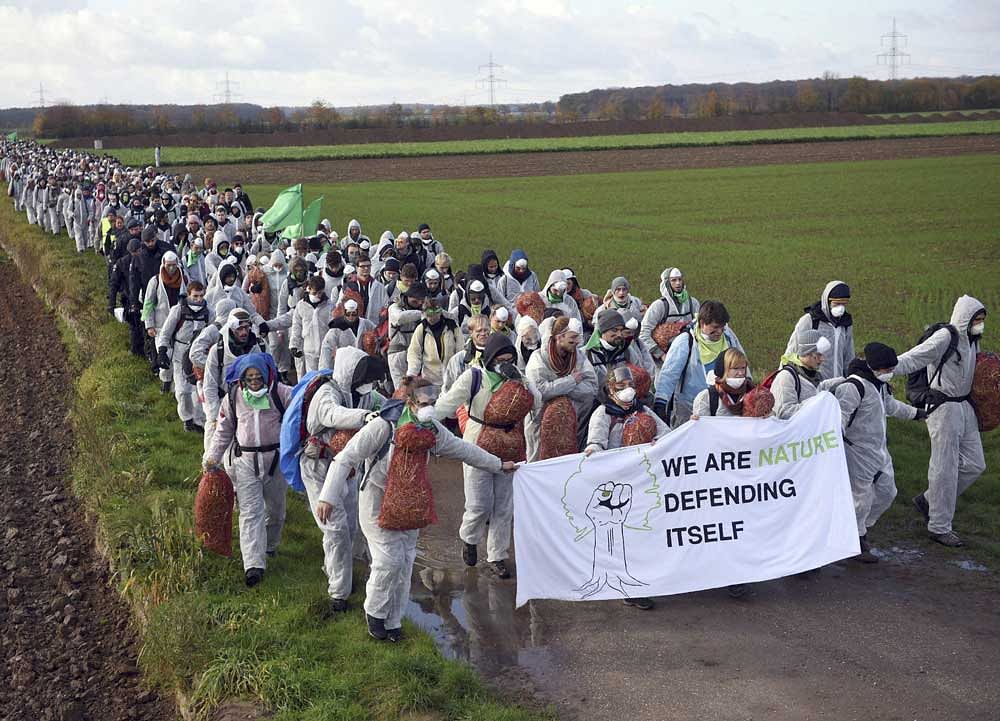Protests, public lie-downs, blockades and arrests have marked the civil disobedience protests that are part of the assortment of global movements collectively making up the climate strikes. Strikes by schoolchildren have merged with protesters who are part of several groups: the divestment movement, 350.org, scientists, labour, the Sunrise movement, indigenous rights groups, Extinction Rebellion, and local communities protesting for clean air and ecosystems. These non-violent movements have united against fossil fuel companies and recalcitrant political leaders.
While some observers have called civil disobedience the refusal to obey specific laws, others have regarded it as a protest against the very injustice of the law. The climate protests share some features with the civil disobedience movement that was part of India’s freedom struggle. Peaceful demonstrations and non-violent resistance strikes were the main feature of M K Gandhi’s struggle against the British. Gandhi’s long march to Dandi in 1930 opposing the British monopoly on salt was like a wedge opening the door to nation-wide acts of resistance, bringing together different groups against colonial rule in India. Gandhi’s simple tactic to protest against the salt tax is similar to Greta Thunberg sitting outside school, opposing the way leaders are handling climate change. Such acts come out of desperation but are also calculated means to draw attention to injustice with self-respect and dignity.
India’s freedom movement, and even the US struggle against the same colonial ruler, was at various points typified by lawsuits filed against the British using their system to win legal battles, both large and small. Similarly, one finds a growing surge of climate-related lawsuits in the US, the bottom line for all of them being — you caused climate change, we hold you responsible, so pay up. Many US cities, counties, and the state of Rhode Island have filed lawsuits against fossil fuel companies, seeking compensation for damages caused. Several towns and cities have to invest large sums to protect themselves from likely damage from future climate change. This might include building sea walls, retrofitting stormwater drains so they can handle more intense storms, protecting coastal properties and preparing infrastructure for the impacts of climate change.
Young people have also joined in filing such lawsuits. In Juliana vs the United States, 21 youth are attempting to stop fossil fuel companies in their tracks. An Alaskan village sued oil, power and coal companies because it was being forced to relocate as people were threatened by rising seas. In other countries, too -- the Netherlands, Canada, the EU and in Ireland -- lawsuits were filed against their governments seeking more ambitious action against climate change, and sometimes against fossil fuel companies like Shell, Exon, Chevron and British Petroleum. Not one of these cases has so far been won by the plaintiffs. But even a single win could light the way for larger battles against carbon polluters.
Attack on finances
The Khadi movement in India’s colonial struggle was a campaign for self-respect, supplementary work and building an ethical economic system. In comparison, the attacks on finances of fossil fuel companies can be seen as an indictment of the immoral capitalist order destroying the planet. The climate divestment movement aims to pressure institutions and insurance companies to divest from fossil fuel companies. This network of campaigns has had a series of small and now, increasingly, larger victories. The institutions divesting are mostly faith-based, philanthropic, educational, government and pension funds. Most recently, the University of California’s $70-billion pension fund promised to divest.
Future forward
The climate movement’s call for climate justice is seen everywhere on its banners. But movement leaders need a better understanding of the foundations of climate justice, and its implications for global politics and policies. Foremost is the ironical fact that climate impacts will affect the poorest countries far more than wealthier ones that are responsible for the bulk of the accumulated greenhouse gases (GHG) in the atmosphere. Without financial and technological support, developing countries cannot implement appropriate policies for reducing GHG emissions and adapt to a warming world.
There are plenty of people opposed to the climate strikes, and they are not all fossil fuel companies or those funded by them. People sympathetic to markets, who fear disrupting the prevailing economic order, those who fail to recognise the urgency of the climate problem, and many who still deny the science of climate change, dispute the strikers. The freedom struggle had many dissenters, too -- those who were part of the government or failed to understand the importance of freedom or those that felt threatened and afraid of possible changes to their power.
The climate strikers need to keep the faith and continue, because it seems that theirs is the force that has the most visible impact by uniting several voices. Much like those who decry Greta Thunberg, Gandhi, too, was called many names: a mad man, a moral extremist and a half-naked fakir. In the end, his efforts and those of India’s anti-colonial movement succeeded. So too, the climate strikers hope, might we win in our struggles against climate change and the leaders who fail to act to address it.
(The writer is a scientist whose interests are science, technology and policy)
